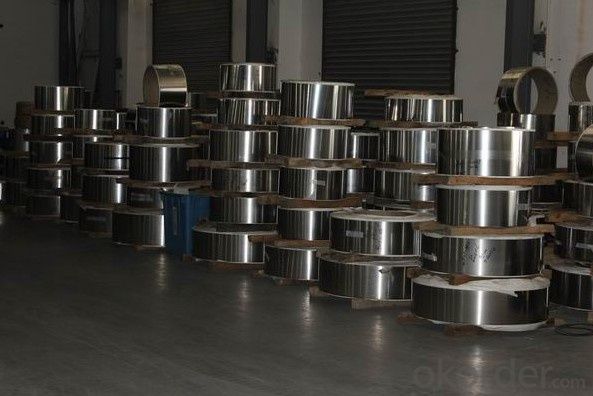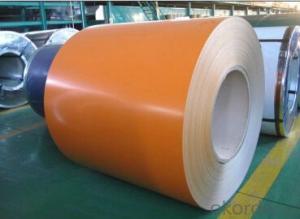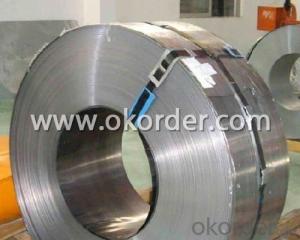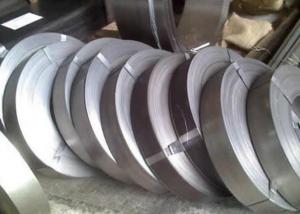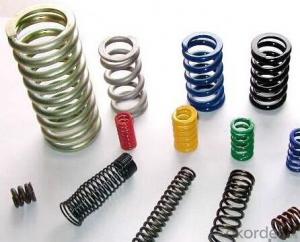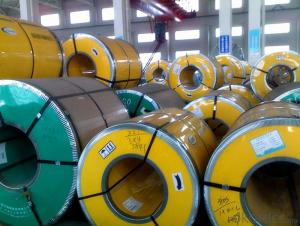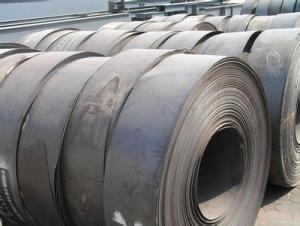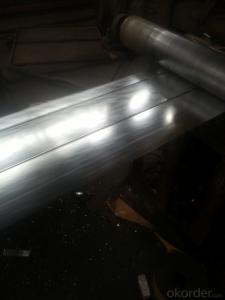Stainless Steel Strip
- Loading Port:
- China Main Port
- Payment Terms:
- TT OR LC
- Min Order Qty:
- -
- Supply Capability:
- -
OKorder Service Pledge
OKorder Financial Service
You Might Also Like
Specifications
Standard:ASTM A554
Thickness: 0.2mm - 2.5
Surface: BA / 2B / satin
width:25-500mm
package:wooden case
Name: Stainless Steel Tube welded
2.Standard: JIS, GB, DIN, ASTM, EN, AISI
3.Materials: AISI 201, 202, 301, 304, 304L, 316, 430, etc.
4.Size: a) Width: 25-500MM
b)Thickness: 0.2-5.0mm,
Other specifications are welcome from your request.
5.Finishing: annealed, pickled, polished inside and outside
grit: 2B(Mill Finish), 2D, 180#, 320#, 400#, 600#, HL, Mirror, satin, bright,etc.
6.Packaging: woodden case
7.Application: widely used in sewerage disposal, decoration,food, beverage, milk, refine sugar, medicine, etc.
8.Best products+best price+best servive
- Q: How are steel strips processed further for specific applications?
- Steel strips are processed further for specific applications through various methods such as cutting, shaping, and heat treatment. These processes help to achieve the desired dimensions and properties required for different applications. Additionally, surface treatments like coating or plating may be applied to enhance the steel's corrosion resistance or aesthetic appearance.
- Q: How are steel strips used in the production of surgical instruments?
- Due to their unique properties, steel strips are essential for the manufacturing of surgical instruments. These strips, typically made from high-quality stainless steel, offer exceptional strength, durability, and resistance to corrosion. To begin the manufacturing process, the steel strips are cut into precise dimensions, ensuring uniformity and accuracy in the shape and size of the surgical instrument. Specialized machinery, such as press brakes or bending machines, is then used to shape the strips into various components like handles, blades, clamps, or forceps. To achieve the desired shape and functionality of the surgical instrument, the steel strips undergo additional processing techniques such as forging, stamping, or machining. Forging involves the application of heat and pressure to mold the steel strip into complex shapes, enhancing its strength and durability. Stamping utilizes a die to cut or shape the steel strip, resulting in intricate designs or patterns on the instrument's surface. Machining, on the other hand, utilizes computer-controlled tools to remove excess material and create precise cuts, holes, or threads. Furthermore, heat treatment can be applied to the steel strips to improve the mechanical properties of the instrument, such as hardness or flexibility. This involves subjecting the steel to controlled heating and cooling cycles, resulting in a desired microstructure that enhances the instrument's performance and lifespan. Once the components of the surgical instruments are formed, they undergo meticulous assembly, polishing, and inspection to ensure they meet stringent quality standards. The corrosion-resistant properties of the steel strips are particularly crucial in surgical instruments, as they are exposed to various sterilization methods like autoclaving or chemical disinfection. In summary, steel strips are crucial in the production of surgical instruments, providing strength, durability, and corrosion resistance. Through shaping, processing, and assembly, these strips ensure precision and reliability in surgical procedures.
- Q: How are steel strips used in the production of conveyor belts?
- Steel strips are used in the production of conveyor belts by being embedded within the belt material to provide strength, stability, and durability. They help to reinforce the belt and prevent it from stretching or deforming under heavy loads, ensuring smooth and efficient material transportation.
- Q: What are the common industry standards for steel strips?
- The specific application and usage of steel strips determine the varying common industry standards. However, the steel industry commonly adheres to several well-known standards. One notable standard is the American Society for Testing and Materials (ASTM) standard. ASTM A109/A109M specifies the requirements for cold-rolled carbon steel strips with a maximum carbon content of 0.25 percent. This standard outlines guidelines for the chemical composition, mechanical properties, and dimensional tolerances of steel strips. Another widely used standard is the International Organization for Standardization (ISO) standard. ISO 9445 covers the dimensions, surface quality, and mechanical properties of continuously hot-rolled steel strips and plates. Additionally, specific regions have their own standards. For instance, the European Committee for Standardization (CEN) has developed the EN 10139 standard, which outlines the requirements for cold-rolled narrow steel strips in Europe. Moreover, industries like automotive, construction, and manufacturing often have their own unique standards and requirements for steel strips. These standards are typically established by industry associations or regulatory bodies to ensure the safety, quality, and performance of steel strips in their respective applications. In conclusion, while there are various common industry standards for steel strips, it is crucial for manufacturers, suppliers, and end-users to consult the applicable standard for their region and specific application to ensure compliance and meet the necessary specifications.
- Q: What are the different edge conditions available for steel strips?
- There are several different edge conditions available for steel strips, each serving a specific purpose and catering to different application requirements. Some common edge conditions for steel strips include: 1. Mill Edge: This is the most basic edge condition where the steel strip is left as it comes off the mill. It has a natural rolled edge without any additional treatment or processing. 2. Slit Edge: In this edge condition, the steel strip is slit to the desired width, resulting in two slit edges. Slit edges are generally rougher and have burrs due to the slitting process. 3. Deburred Edge: To remove the burrs and sharp edges that may be present on a slit edge, the steel strip is deburred. Deburring helps to improve safety and prevent damage during handling. 4. Rounded Edge: This edge condition involves rounding the edges of the steel strip to remove sharp corners and create a smoother profile. Rounded edges are commonly used in applications where safety, aesthetics, or ease of handling are important. 5. Burr-Free Edge: This edge condition is achieved by removing all burrs and sharp edges from the steel strip. Burr-free edges are often required in applications where precision and quality are critical, such as in automotive or electronic industries. 6. Trimmed Edge: In this edge condition, excess material is trimmed or removed from the edges of the steel strip to achieve a specific width or to improve dimensional accuracy. 7. Beveled Edge: A beveled edge is created by cutting or grinding a specific angle along the edge of the steel strip. Beveled edges are often used to facilitate welding or joining of steel strips, providing a better fit and increasing the strength of the joint. These different edge conditions for steel strips offer a range of options to meet the specific needs of various industries and applications. Choosing the right edge condition is crucial to ensure optimal performance, safety, and functionality of the steel strip in its intended application.
- Q: What are the different methods for punching steel strips?
- There are several different methods for punching steel strips, depending on the specific requirements and desired outcomes. Some of the most common methods include: 1. Mechanical punching: This method involves using a mechanical press or punch press machine to create holes or shapes in the steel strip. The machine applies force to a punch and die set, which cuts through the material. Mechanical punching is suitable for high-volume production runs and provides precise and consistent results. 2. Hydraulic punching: Hydraulic punching utilizes hydraulic power to drive the punch through the steel strip. This method is often used for heavier gauge materials or when higher force is required. Hydraulic punching is known for its ability to create larger holes and shapes in the steel strip. 3. Laser cutting: Laser cutting is a non-contact method that uses a high-powered laser beam to accurately and rapidly cut through the steel strip. This method offers great flexibility in terms of shapes and sizes, and can create intricate designs with high precision. Laser cutting is often preferred when complex patterns or curves are needed. 4. Plasma cutting: Plasma cutting involves using a plasma torch to cut through the steel strip. The torch generates a high-temperature plasma arc that melts and blows away the material, creating the desired shape. Plasma cutting is commonly used for thicker steel strips and can achieve high cutting speeds. 5. Waterjet cutting: Waterjet cutting uses a high-pressure jet of water mixed with abrasive material to cut through the steel strip. This method is suitable for various materials, including steel, and is known for its ability to create precise and clean cuts without heat-affected zones. Waterjet cutting is especially useful for cutting materials that are sensitive to heat or prone to distortion. Each method has its own advantages and considerations, such as cost, speed, precision, and suitability for specific steel strip thicknesses and shapes. The choice of method will depend on the specific requirements of the project and the desired outcome.
- Q: What are the different edge conditions of steel strips?
- The different edge conditions of steel strips refer to the various types of edges that can be found on steel strips. These edge conditions are important considerations in many industries where steel strips are used, such as manufacturing, construction, automotive, and aerospace. 1. Mill Edge: The mill edge is the most common edge condition of steel strips. It is the edge that is produced during the manufacturing process at the steel mill. The mill edge is typically rough and has not been processed further. 2. Slit Edge: Slit edge is another common edge condition where the steel strip is cut into narrower strips. This edge condition is achieved by using a slitting machine. Slit edges are usually smoother compared to mill edges, but they may have some burrs or roughness. 3. Sheared Edge: Sheared edge is an edge condition obtained by cutting the steel strip with a shearing machine or a guillotine. This process results in a straight and square edge, but it may have some burrs or sharpness. 4. Deburred Edge: Deburring is a process used to remove any burrs or sharp edges from the steel strip. This edge condition is achieved by using grinding or sanding techniques. Deburred edges are smooth and safe to handle. 5. Rounded Edge: In some applications, steel strips may require rounded edges for safety or aesthetic reasons. This edge condition is achieved by using a rounding machine or by rolling the edges. Rounded edges are smooth and prevent the risk of injury from sharp edges. 6. Beveled Edge: A beveled edge is an edge condition where the edge of the steel strip is cut at an angle. This type of edge is often used for welding purposes, as it allows for better penetration and a stronger joint. Beveled edges can be customized to various angles depending on the welding requirements. These different edge conditions of steel strips cater to specific needs and applications across various industries. Manufacturers and users of steel strips must consider these edge conditions to ensure the suitability and functionality of the steel strips in their specific applications.
- Q: How are steel strips used in the production of metal brackets?
- Steel strips are commonly used in the production of metal brackets due to their versatility and durability. These strips are typically made from high-quality steel, which provides the necessary strength and stability required for brackets. In the manufacturing process, steel strips are first cut into the desired length and width, depending on the specifications of the bracket being produced. This allows for greater flexibility in creating brackets of different sizes and shapes. Once the steel strips are cut, they go through a series of forming operations, such as bending, stamping, or rolling, to shape them into the desired bracket design. These forming operations can be done using various machinery and techniques, depending on the complexity of the bracket. Steel strips also play a crucial role in ensuring the brackets' structural integrity. They provide a solid foundation and support for the bracket, enabling it to withstand heavy loads and maintain its shape under pressure. This is especially important in applications where the brackets are used to support heavy objects or machinery. Additionally, steel strips are often coated or treated to enhance their corrosion resistance. This is vital in applications where brackets may be exposed to harsh environments or corrosive substances, as it helps prolong their lifespan and maintain their functionality. Overall, steel strips are an essential component in the production of metal brackets, providing strength, flexibility, and durability necessary for various applications.
- Q: How do steel strips contribute to chemical resistance in various applications?
- The chemical resistance of various applications is enhanced by the use of steel strips, thanks to their inherent properties and protective coatings. Firstly, steel is renowned for its incredible strength and durability, thus rendering it suitable for handling harsh chemicals. It can endure mechanical stress and preserve its structural integrity, even in aggressive surroundings. Moreover, steel strips can be coated with a variety of materials to enhance their chemical resistance. One common coating method is galvanization, which involves applying a layer of zinc to the steel. This zinc layer acts as a sacrificial barrier, shielding the underlying steel from corrosion caused by chemicals. Another option for coating is the use of polymeric coatings, which provide a barrier against chemical attacks and can be customized to suit specific applications. Furthermore, steel strips can be designed with specific alloy compositions to improve their chemical resistance. For instance, stainless steel strips contain chromium, which forms a passive oxide layer on the surface. This protective layer prevents corrosion and offers resistance against a wide range of chemicals. Steel strips play a vital role in various industries where chemical resistance is paramount. In the chemical processing industry, they are utilized in equipment such as tanks, pipes, and valves, which must withstand corrosive substances. The automotive industry also relies on steel strips for components that come into contact with fuels, oils, and various chemicals. Additionally, the construction industry utilizes them for structures exposed to aggressive environments, such as bridges and offshore platforms. In conclusion, steel strips contribute to chemical resistance in diverse applications due to their inherent properties, protective coatings, and alloy compositions. They provide strength, durability, and resistance against corrosion, making them indispensable in industries concerned with exposure to harsh chemicals.
- Q: Can steel strips be used for making architectural components?
- Yes, steel strips can be used for making architectural components. Steel strips are often used in construction due to their strength, durability, and versatility. They can be shaped, bent, and welded into various architectural components such as beams, columns, trusses, and frames. Furthermore, steel strips can be finished with different coatings or treatments to enhance their aesthetic appeal and protect them from corrosion. Overall, steel strips are a popular choice for architectural components due to their structural integrity and design flexibility.
Send your message to us
Stainless Steel Strip
- Loading Port:
- China Main Port
- Payment Terms:
- TT OR LC
- Min Order Qty:
- -
- Supply Capability:
- -
OKorder Service Pledge
OKorder Financial Service
Similar products
Hot products
Hot Searches
Related keywords



